Abstract
Through two interviews conducted two years apart, the author and artist Joey Terrill offer an intimate historical trajectory rooted in the singular voice of the artist through the discussion of artworks in the exhibitions “Joey Terrill: Still Here” and “Joey Terrill: Once Upon A Time: Paintings, 1981–2015”. The method of storytelling, interview, and art representation chronicles the artist’s emotional, intellectual, and embodied experience of illness, queerness, and resistance as an HIV-positive queer Chicano.
Keywords:
HIV/AIDS; still life; queer Latinx/Chicano art; Pop Art; homage; Homeboy Beautiful; maricón; malflora; maricónography 1. Introduction
When I saw a photograph of a line of Chicanxs jotxs on Los Angeles’s Hollywood Blvd. wearing shirts emblazoned with “maricon” (fag) and “malflora” (dyke) on the chest, I felt a sense of confirmation. With that photograph, I finally encountered the queer Latinx art history that I knew existed yet did not know. Walking in a parade organized by Christopher Street West (a West Coast organization aligned with the New York City 1969 Stonewall uprising), I saw artist Joey Terrill (born 1955 in East Los Angeles, where he currently has a studio) and other Chicanx people and their t-shirts: my first contact with a world of queer Latinx art and activism which has since bloomed into a book project. Joey Terrill put his stamp on queer Latinx art and art history, both as the maker of those hand-painted t-shirts in June 1976 and as someone at the epicenter of a network of queer Latinx artists. Terrill’s work as an artist activist addresses the queer body, its visibility, and its subsequent relationship to HIV/AIDS.
Inspired by popular culture, and artistic movements of the 1950s and 1960s, Joey Terrill began making art as well as participating in Chicano and queer social justice movements in 1970s Los Angeles. Terrill met fellow Chicano gay artists Jim Aguilar, Gronk, Robert Legoretta (Cyclona), Mundo Meza, and Teddy Sandoval. A prolific maker of paintings, prints, drawings, ‘zines, and a participant in the mail art movement, his 1978 Homeboy Beautiful, which would later become his Instagram name, featured a mock photographic documentary of the “homo-homeboys” of East Los Angeles. Terrill moved to New York City in 1980, making his series of “Chicanos invade New York”. Terrill experienced his community reeling from the AIDS crisis, returned to Los Angeles, and was diagnosed HIV-positive in 1989. Since then, Terrill has supported himself through a demanding and important career working in AIDS advocacy, interweaving this day job with his prolific artistic practice centering his familial, artistic, and activist communities.
Terrill’s background, personal trajectory, and demeanor are that of a person grounded in having earned a living. After more than forty years of work primarily in HIV/AIDS care and advocacy, Terrill left his day job just a few months before our first interview. In 2021, Terrill and I met at Ortuzar Projects in New York City’s Tribeca neighborhood on the last day of his first solo gallery exhibition, “Once Upon A Time: Paintings, 1981–2015”, to reflect upon his paintings based on his time in New York City. In 2024, we met at his exhibition “Still Here” at Marc Selwyn Fine Art in Beverly Hills, accompanied by his partner, curator and art historian Rafael Barrientos Martínez, to discuss his still-life paintings of HIV medications in domestic settings, and then traveled to his studio in Boyle Heights. Through the conversations, we discussed food as home, the “after” of the relationship with great loves, 1980s New York, exposing ourselves through our bodies, Chicana feminism, the invisibilization of queer Chicanx bodies, rebelling against masculinist norms, queerness versus homosexuality, re-encounters with crushes, queer solidarity across genders, the fluidity of Asco collaborations, making emotionally resonate (rather than strictly political) work about HIV/AIDS, Pop Art influences, homages to queer artists, and the pharmaceutical industry.
The few years between our conversations mark his transition to working as a full-time artist through not only his retirement but also the belated interest of art institutions and the art market. Scholar Robb Hernandez proposes that Terrill’s work enacts “maricónography”. Hernandez’s term melds the words maricón (fag) and iconography, to theorize how Terrill’s work visualizes a form of being queer or gay that is distinctly Chicanx, specifically “from a decidedly working-class viewpoint”. Generous and filled with gratitude, navigating eminent artworld stardom with humility and wonder, Terrill sometimes comments upon the very different spaces he now straddles.
Terrill has not only inhabited but also links several worlds. Intersectional before the term was coined, his work allowed for my intergenerational understanding of the history I sought. Finding the “maricon” and “malflora” t-shirts connected me with a queer Latinx ancestry beyond the trope of survival, enabling me to link my work studying artists focused on HIV/AIDS with my own experiences of my closest friends living with the virus. I return to Terrill’s artwork for its approach to the virus with a ferocity clearly forged through enormous loss paired with tenderness for its victims and survivors. Terrill’s visual strategies for representing grief become all the more poignant and iconoclastic through his merging of pop and Latinx cultural references with clean lines, sharp text, vibrancy, lushness, and plenitude.
2. “Still Here”, 13 January–3 March 2024, Marc Selwyn Fine Art
Alexis Salas (AS): You discuss now being HIV positive for 44 years. You mentioned that the genesis of the work in the “Still Here” exhibition, which you started around 1997, is your realization that you were not going to die of AIDS. Might you talk about that realization and its relationship to the “Still Here” works?
Joey Terrill (JT): For the first 10 or 11 years that I was positive, I thought it was just inevitable that I would die of AIDS. But when I realized I wouldn’t, I had conflicting emotions. I was happy about that, but then I also thought, “gee, how come I’m still here?” And all these other friends, the antiretrovirals didn’t work, or they died six months before they were available, and then at the same time, I had been working in advocacy around the pharmaceutical industry and their price gouging for not just HIV meds, but just healthcare in general, but especially pharmaceuticals.
My usual approach to making my paintings was to work from a single photographic source. So I’d have one image that I would use. I was trying to figure out how I could create paintings about my ambivalence regarding the age of the HIV cocktail and my place in it, and where HIV and HIV meds have now landed in society or popular culture. I just couldn’t figure it out, but one day sitting at my breakfast table with my Cheerios and my HIV meds on the table in front of me, I thought, “Oh, this is funny, it looks like a Tom Wesselman still life from the 1960s”, in which he juxtaposed different images and logos of American products, that at the same time celebrated Post World War II American consumerism but also was critiquing American consumers’ tendencies. And I thought, “Oh, I’ll do a parody, and that’s the way that I can do still lifes with these HIV meds”. But in mine I wanted to both Mexicanize and queerize my versions, so that no one would mistake them for—you know, not that I would be mistaken for [the artwork of American painter] Tom Wesselmann. But anyway, this is the first one that I did. That’s part of why I have juxtaposed those American products but then put either chocolate or galletas or some aspect of Mexican culture.
Rafael Barrientos Martínez (RBM): I want to highlight that in organizing the show that one point that didn’t really come to mind until we finally brought the works together is that you are claiming ownership over all of these 1950s–1960s products that were not being marketed towards Latinos. There’s never been a history of advertising that was meant to reach Mexican-Americans in the United States. We were consumers, but we were ignored. It’s only recently that people see the buying power of Mexican-Americans, but Joey’s claiming a historical ownership with the series as well.
AS: And maybe also claiming ownership over Pop Art, too?
JT: I did a print with Self-Help Graphics [& Art, a community arts center in East Los Angeles] that I designed when PrEP originally came out. It’s called Prep Can [printed 2023] instead of Soup Can. And instead of the company name I substituted Gilead and Truvada for Campbell’s and in place of soup it says PrEP because PrEP is now ubiquitous within the queer and trans community. The print emphasizes that PrEP is a product just like Campbell’s soup.
AS: In our last interview you talked about differentiating your work from the explicitly political, yet emotionally distanced East Coast practices—not that that work didn’t have emotion or not that your work doesn’t have politics, but there was a different approach. Your work has joy, lusciousness, humor, puns, and innuendo.
RBM: Also, the work is coming out of ambivalence. Fighting for queer visibility and against the pharmaceutical companies, but these were also coming out of a moment where you wanted to celebrate.
JT: Yes, that’s what I’m saying. My ambivalence was a combination of different emotions and feelings. I started the series with a Still-Life with Crixivan [1997–1998] (Figure 1). I recognized that what I was doing was that I was placing HIV or AIDS and the medications in a domestic setting, that was in some ways familiar to most people, most people who are not familiar with HIV and the medications and the drugs. When I held an open studio people would come and say, you know, “Oh, I love the roses” and “Oh, I love the placement of this, but what are these pills?” And when HIV activists came in, they were like, “Oh my god, that’s Crixivan” and I started to recognize that there were two different audiences here, those that were familiar and those that weren’t.
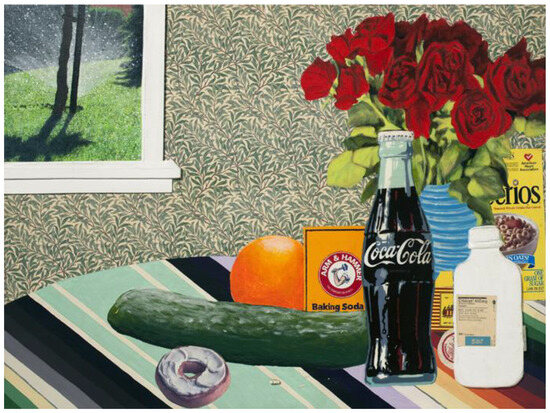
Figure 1.
Joey Terrill, Still-Life with Crixivan, mixed media on canvas, 36 by 48 inches, 1997–1998. Reproduced with permission from the artist.
The other thing about this in the whole series was that back in the ’80s, me and my partner Rick used to hang wallpaper. When we did big jobs, mansions from Santa Barbara to Palos Verdes or Beverly Hills, there was inevitably wallpaper leftover and the client or the designer would say, “Oh, it’s trash, lets trash it”, and I would say, “Oh my God, this paper’s too beautiful”. And I thought, “One day I’ll figure out where I can use this in art”. Okay? But I carried them for about 15 years from studio to apartment, never figuring out where I would be able to use it. And then I decided, this is where. In the Still-Life series, I then used the wallpaper to play with this sense of reality, make it faux, right? What’s real? What’s unreal? What’s surreal? Because it still was a moment of feeling surreal, but I couldn’t believe that I was now going to continue living. It also was a reminder of my relationship with Rick, and he died about ten years ago. We were partners, very dysfunctional for eight years, and then we became really good friends for 38. There’s a personal aspect to it. The wallpapers are real. They relate to me. Everything else is just, you know, made up.
AS: The medicine is real capsules and the labels are from your bottles, yes?
RBM: The Cheerios box is real as well.
JT: The Cheerios box is. And also the Ibarra chocolate. But with this, Crixivan, when I was tested in ‘89 at that time there was no treatment for AIDS. But my doctor, Dr. Rogolsky, had said, “As you know, the current thought is that even if you test positive, you don’t have to wait to get sick before you take medications. There are clinical trials, you can stave off the progression to AIDS”. I said, “Please sign me up”. And I was on a clinical trial at UCLA for Crixivan. One of the possible side effects of the Crixivan, though, was kidney stones, and it was painful, horrible, and so I had to get out of that trial. And so I still had a bottle with, you know, maybe a half dozen Crixivan capsules, that had just stayed there in my studio. Still-Life with Crixivan is the first painting where I actually used the capsules and put them in there. My intention at first was to consider using actual capsules and pills in all of them but as I started to do them, I recognized that all the playfulness that I was having fun within terms of the perspective being off and the size and shape of things and the colors, that maintaining the capsules would not work—they’re all very small. So I then started to experiment with making the capsules larger.
This one is called The Sweeter the Juice (Figure 2), which includes two capsules of Reyataz. And this is when after several years of doing these still lifes, I realized that I never had any figures in them and I thought, “maybe it’s time for me to start to put some figures in”. And at the time, I didn’t have a partner, but I was trolling the hookup sites and I started to use images from them. So, you know these gentlemen were collaborating with me unknowingly by using their images. And there’s several of them that I did where the image itself, not in this one, they don’t show their faces; they are just showing their body or their body parts and part of that is because they’re on the down low, right? And I already knew that being on the down low is actually a partial cause of the high rates of HIV among communities of color and Latinos, right? And so I started to put those images in there, which, to me, was subliminally indicating I’m thankful. I have these medications that keep me a thriving homosexual.

Figure 2.
Joey Terrill, The Sweeter the Juice, mixed media on canvas, 48 × 60 inches, 2003. Reproduced with permission from the artist.
RBM: And this is one of three works where you included figures.
JT: Yeah, the three works where I included figures were because at that point in time I finally had the cocktail that consisted of three components—Reyataz, Norvir, and Truvada. And so I thought, rather than having all three in one, I was going to do a painting dedicated to each of those. So this one is Reyataz. And then I did one with Truvada. And then I did one for the Norvir. And each of those has a figure.
AS: Would you talk a little bit about how sustenance in different forms, whether it be medicine, sexuality, or food, is a theme in your work?
JT: I recognized that I was doing parodies of Wesselman still lifes. One of the things that I found interesting about them was that they are of their time. So whatever products he depicts, the logos and labels, the branding, is of the late ‘50s or 1960s, right? So, whereas, by the 1990s and ‘80s, everything had changed visually. I was specifically looking at imagery that came from the ‘60s or ‘50s because I was born in 1955. Some of these are old logos and older branded images. So it is even more likely that you’re not going to find them today. They’re adding to their “totally being made up” so to speak.
Still-Life with Triumeq and Wrapped Candies that Remind Me of the Artist Felix González-Torres (Figure 3) from last year was a homage to Felix, but also a reaction to the little kerfuffle at a museum in the Midwest where, at the request of the Felix González-Torres Estate, they changed the text and the description of a González-Torres’ work eliminating any mention of AIDS or HIV and people got alarmed. And I thought, you know, there’s still that element of wanting to remove or make invisible HIV/AIDS, even in the art world, and so I intentionally chose that.
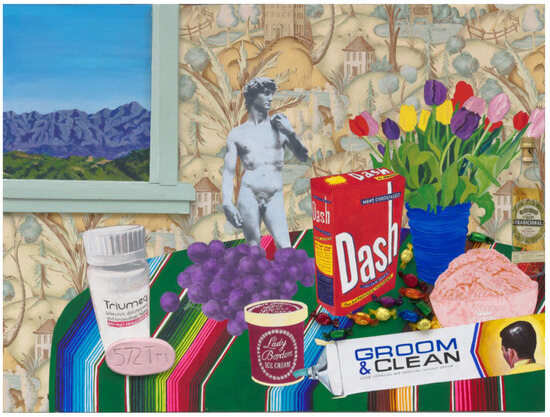
Figure 3.
Joey Terrill, Still-Life with Triumeq and Wrapped Candies that Remind Me of the Artist Felix González-Torres, acrylic and mixed media on canvas, 36 by 48 inches, 2023, Collection of the Santa Barbara Museum of Art. Reproduced with permission from the artist.
AS: Yes, this is part of a discourse of the supposed “universalization of the artwork” which assumes that identity is an overly-specific, contaminating marker.
JT: Thinking about censorship of artwork, as you can see here, in that same painting referencing González-Torres, I put in a little statue of Michelangelo’s David because I was outraged about the teacher in Florida who was reprimanded because a parent complained that David was porn. One thing that I don’t understand is, unilateral censorship based upon one parent’s complaint.
Anyway, in Still-Life with Videx (Figure 4), you can see I’ve had fun and filled the canvases with puns, sexual innuendo, maybe even comments on gender, and looked at old logos for, in this case, Peter Pan Peanut Butter. Peter Pan’s place in culture is a boy that never grows up, when, in theater, the role was always assigned to a female. But in this historic logo, Peter Pan is far from being a little boy or petite female. I mean, she’s tall, she looks like a giant.
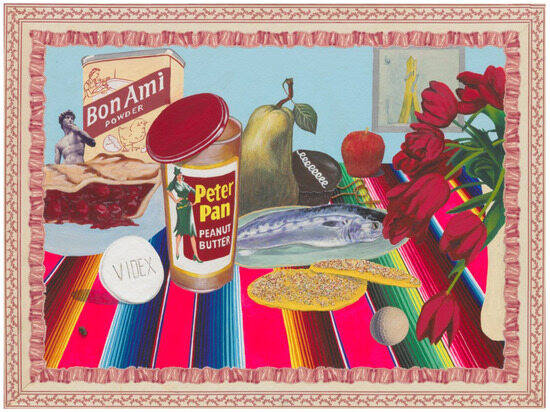
Figure 4.
Joey Terrill, Still-Life with Videx, mixed media on canvas, 36 by 48 inches, 1999–2000. Reproduced with permission from the artist.
AS: Amazonian!
JT: And she’s got her arms akimbo here. She’s standing and smiling; she’s got the little tilt of her hat. And I thought, “Oh, she’s Peter Pan; this is an intriguing one to use”.
But I think it comes to the 1950s. In the same painting I then also included another female image with an old Bon Ami cleaning powder, but of course the woman there is with her apron, and she’s cleaning the bathtub, implying misguidedly a woman’s role is in the home. Again, people can read things into it, but I also thought it was interesting that the Bon Ami powder had a baby chick. And I knew that, you know, chick can be used also as a euphemism for girls. And then that’s why I had chosen to include the David in this work as well to contrast with the female imagery. I also included a souvenir from the Vatican. It’s a wooden rosary and it says “Vaticano”.
AS: A play on the Vatican, the seat of the Catholic church, and vato, slang for dude.
JT: Yeah, then the galletas, the cookies, there, which have real sugar balls. Then this poor little guy, this was a beetle that I found on the doorstep of my studio one day. And I thought, “Oh, why is he here?” But it was one that was iridescent, blue-green, really beautiful. You can barely see it today… if you look on this side there, but it’s sort of lost its umph.
AS: The conservation team must not be happy with you.
JT: I know, as you can see some of the sprinkles have faded and some have fallen off, but you know its…
RBM: But we’ve decided to embrace the fact that you chose to incorporate ephemeral materials and leave it be.
JT: This is Sustiva Still-Life (Figure 5). Sustiva is part of the HIV cocktail. At the time, my doctor said, “Let’s try you on Sustiva and see how it goes”. And he informed me that one of the side effects of Sustiva is that it produces extremely vivid dreams. And I thought, “Oh, that sounds great”. But I mean, these dreams are unlike anything I’ve ever experienced. They would cover characters or a family for generations, like starting out in the 17th, 18th century with horse-drawn buggies, and I could see every detail of the clothing, the lace, the collars, the jewelry, the people, you know everything, and then as they progress and then die off, and then it goes into the 1950s, and their great grandchildren are now continuing going into like the space age and the Jetsons. I mean all within one dream and it was just remarkable.
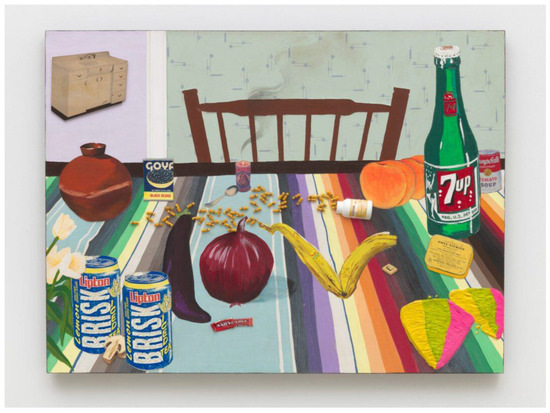
Figure 5.
Joey Terrill, Sustiva Still-Life, acrylic and mixed media on canvas, 36 × 48 inches, 2000–01. Reproduced with permission from the artist.
AS: The psychedelic powers that are given to people who are taking care of their bodies…
JT: But I would find myself waking up in the morning and it would take me a minute to realize, “Oh wait, I was just dreaming”. So I decided I’m going to put my tablet right by my bed, and when I wake up, I’m gonna write every detail that I can remember on this dream. And so I did that, and I must have written about four or five, maybe five, six pages on my yellow tablet, and then I woke up, and I realized I had just dreamt that I had written all this stuff, and I’m staring at an empty tablet and I thought, “Oh my God, this is so weird”. So that’s why I said, “You know what, I can’t do this drug”. So that’s why I had a lot of leftover Sustiva. With this one, I thought it was important to actually put the capsules and create this surreal back and forth between what’s real and what’s not.
AS: Like poppers in their old school form.
JT: Yeah, when they were originally produced and used for instance by the military as smelling salts they took this form. They came in little glass vials surrounded by netting so that you would break the glass and the netting would keep it all contained. But when you broke it, it would pop. It made a sound, and that’s why they’re called poppers. And I love to tell this to so many young gay men who are not familiar with this history these days. But anyway, that’s part of this here.
AS: Tell me about the kitchen and Native American pottery in this same painting.
JT: Yeah, I think it’s Native American and I borrowed it from a book and I wanted to contrast it with a 1950s sink. I was looking through old magazines when I came across these kitchens and I thought, “Oh you know that’s the kitchen that I grew up with in Santa Fe Springs” and I thought, “How can I bring these small appliances in?” Because in these paintings, everything was always in the foreground. So I decided to put a wall in with trim to indicate a background and depth”. I also played with the items overall so that if you stretch your mind a little bit or smoke a joint, you could perhaps make out that the eggplant, onion, banana, and scrabble letter spell out “L”, “O”, “V”, “E”, and it’s repeated on the clove gum wrapper. So again, just playing with the idea of wordsmithing. And then these galletas have always fascinated me, the ones that are vivid dayglo pink, green, and yellow. A lot of non-Mexicans or non-Chicanos would say, “What are those exactly?” And this [Bite Me] (Figure 6) was loaned to the exhibit; it belongs to William Escalera and Francisco George. This is a still-life that does not contain HIV meds. I was thinking in terms of the cornucopia or horn of plenty showing abundance. Here, I decided to put an image from a Calvin Klein underwear ad from the ‘90s. It’s a still-life celebrating sensuality or sexuality and the title is provocative because it’s a rebuke to homophobic society but it can also be read as instructions to take a bite out of the fruit or the hunk. I also put the little angelito that’s usually pictured under the Virgen de Guadalupe, and so it’s sarcastic and sacrilegious.
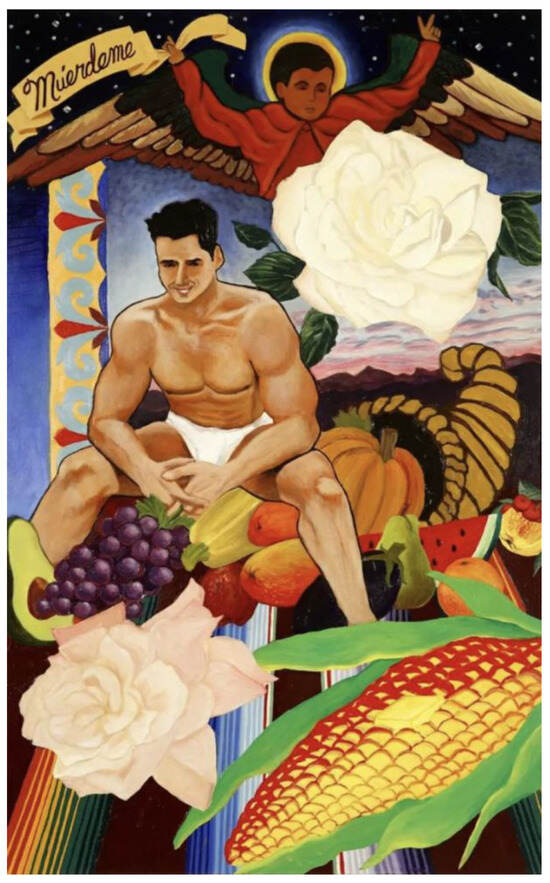
Figure 6.
Joey Terrill, Bite Me!, acrylic, oil, and rhinestones on canvas, 48 × 30 inches, 2004. Collection of William Escalera and Francisco George. Reproduced with permission from the artist.
AS: Moving the angelito who is normally below the Virgen de Guadalupe from the bottom to the top of the image changes the gesture so greatly: he looks like he’s taking a selfie or expressing dissent. It makes him a different kind of figure than the supporter of the mother of Mexico.
JT: For me the idea was to put homoerotic imagery in paintings that have elements that people might find attractive but in untraditional ways that make viewers think. I know that people go, “Oh, I love the roses, or the flowers”, but then say “Why is he in there”, right? But again, it’s, I think, celebratory and just for fun.
In this small one called Still-Life with HIV Cocktail it has all three components that make up my daily cocktail. Gilead is the company that makes Truvada and that’s that blue pill. Norvir is the white one which is also in Black Jack 8 (Figure 7) that is now over at El Museo del Barrio. And then Reyataz is that capsule there. I started to realize, well, you know what? The pills themselves can also be painted small. I don’t have to do them big. This set me down the road of producing some small scale still-lifes like the next one.
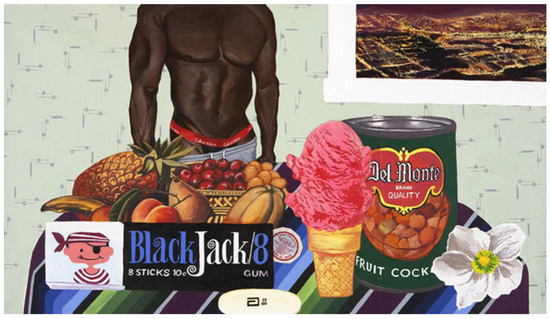
Figure 7.
Joey Terrill, Black Jack 8, mixed media on canvas, 30 by 51 inches, 2008–2009. Collection of El Museo del Barrio. Reproduced with permission from the artist.
AS: With the butterflies.
JT: Yeah, this is called Still-Life with Two Blue Pills (Figure 8). And you have Truvada produced by Gilead, again, and Viagra by Pfizer. When this was done, in 2014, Truvada had been approved by the FDA for use as PrEP, pre-exposure prophylaxis, for individuals who are HIV negative, so they could take it on a daily basis to prevent contracting HIV. So in this painting you’ve got the erectile dysfunction drug and a pill that if you have HIV it could be a component of their meds to keep them alive. If you’re HIV negative it’s now a preventive pill. My friend Pam, who’s a physician’s assistant, pointed out to me that looking at these still-lifes, they chronicle the progression of HIV medications. She said, “I don’t prescribe Videx anymore. That’s such an old one”. So now today, I only take one pill a day, and that’s the Triumeq. I’m trying to explore and have as much fun with the new versions of the Still-Lives, but I’m also thinking that I’d like to, as I did with Felix González-Torres, pay homage to the artists who are no longer here. If I’m gonna to keep making these still-lifes, let me use that as a vehicle to remind people of artists that are no longer here. And this one here, it’s just—
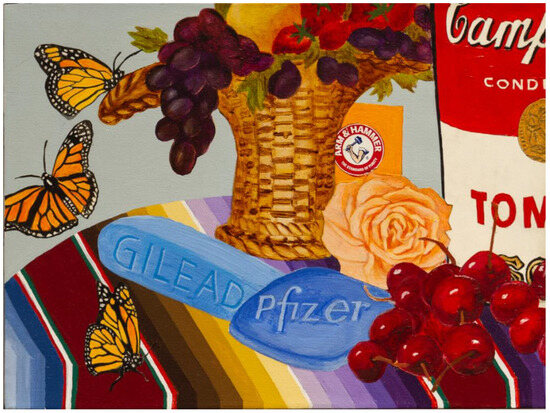
Figure 8.
Joey Terrill, Still-Life with Two Blue Pills, mixed media on canvas, 12 by 16 inches, 2014. Reproduced with permission from the artist.
AS: With the Zote and the Old Dick?
JT: Yeah, and that Old Dick is totally made up. That’s not an actual-
AS: I was going to look it up because I don’t know the brand Old Dick.
JT: It’s not a brand, it’s a parody that someone created that I found online. Though it did fool me at first when I came across it. I also reference Warhol with the banana here. And then, Teddy Sandoval used to have a drag persona called Rosa de la Montaña. And he would do work, sometimes signed as Rosa, which had female imagery in it at times. I included de la Rosa candy to honor him in my little way.
AS: And Marcel Duchamp’s femme alter ego persona, Rrose Sélavy, maybe? You are pulling from a whole lineage, right?
JT: Yes, exactly. And then I put in jabon Zote. Over here is a series of paintings that I have recreated and updated slightly. In doing this show we had discussed wanting to include these paintings that I did in the ’80s and ’70s before there was HIV and AIDS. I was doing works that were of my community, my partners, friends, and lovers”. I did a whole clone series where I was kind of making fun of my own community where all these gay men who had fought for the right to their individuality but were now dressing alike like lumberjacks or cowboys or something. They poke fun while also celebrating us. Several of those works that I thought would have been great to include are missing. There’s probably about a dozen paintings that could be who knows where and so it occurred to me…
RBM: Well Joey’s former partner, Rick, had loaned them to someone in the valley. When he died no one knew where to retrieve them along with all of his belongings, everything from boxes of his clothes to all of his collection. They are missing and we are trying to locate them if they haven’t already been destroyed.
JT: So I decided, you know what, I’ll just recreate them. So these are re-paintings from the —
RBM: And updated.
JT: Updated from the ‘80s or ‘70s, that I did last year in 2023, specifically for this show. Cause there was no reason not to. This one is of Rick, originally painted in 1978, and it was called He Used to Untie My Shoes. And here I just changed it to Remembering When He Used to Untie My Shoes. The only other difference is that what used to be just a little beige color blanket is now a sarape, there in the background. So that distinguishes it from the original. And then Clone on a Bicycle also belonged to Rick recreated that one. And then Summer Became an Endless Round of Parties, Said the Clone (Figure 9), which was from my clone series as well.
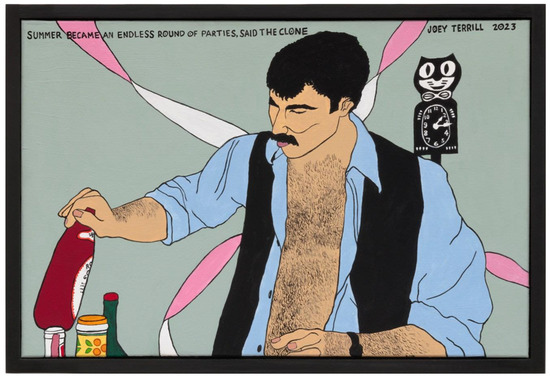
Figure 9.
Joey Terrill, Summer Became an Endless Round of Parties, Said the Clone, acrylic on canvas, 24 by 36 inches, 2023. Reproduced with permission from the artist.
JT: This one is called 50 Christs (Figure 10).
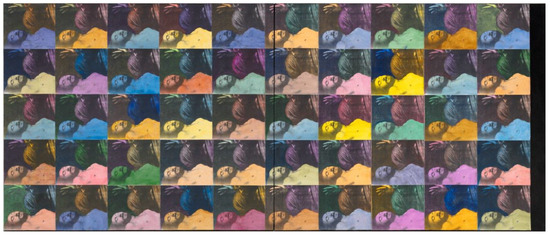
Figure 10.
Joey Terrill, 50 Christs, photocopies and acrylic on canvas, 54 by 128 inches, 2023. Reproduced with permission from the artist.
RBM: You may recall other works from this series that were shown at Ortuzar Projects.
JT: First of all, I always loved the painting The Entombment of Christ by Caravaggio, which this is a little segment of, and it’s the human Christ, the dead Christ. I like that it showed the concern and grief felt by those left behind. And I always loved the gesture of the hand. So I would do these [reproductions of this segment of the Caravaggio painting]. I did eight, then I did 25, which was at Ortuzar. And of course, borrowing from Andy Warhol’s use of repetition. The stopped counting part is implied by the black [line of paint on the right of the canvas].
I stopped counting after 50, after I realized 50 people that I knew had died. I’m like, you know what, I just can’t even. And so it was last year that I decided that I’m going to create a work in the series referencing that.
When I started these I still wasn’t undetectable. I still thought I was gonna die so I was foreseeing that this could be me. But my idea behind it is that because of all the AIDSphobia and homophobia that went on, all the vilification of people with HIV, I felt like, you know what, no, every person that dies from AIDS is deserving of the reverence and grieving that is shown in this painting. I don’t care if they were drug addicts or prostitutes or whatever, right?
I intentionally was using these jewel-like colors which someone pointed out, they said, “Do you know this reminds me of colors like in a stained glass window”. But my eye visually starts to make connections between the colors. I’ll go like, “Oh, you know this purple over here, the grieving, it’s like the same body over here”. And I thought metaphorically it’s sort of the way that HIV was transmitted? But I wasn’t intending that, but that’s once I saw it all together that’s what makes me think.
Over the years I would do these parodies of Robert Indiana’s Love with the word Loss and I would do them in different colors and sometimes I would just do them to give to friends who had lost someone significant in their life. Then in my studio sale, I sold a few. And sometimes I juxtaposed the Loss next to each other, the way that Indiana would do the love paintings.
But this was a separate painting that I had done, and it’s called My Friend Peter [1998], and it’s based on a photograph from 1992, where I was being honored at a dinner fundraiser for VIVA, the organization for gay and lesbian Latino artists.
And I had a friend, Peter Egnozzi who was planning on attending the celebration dinner. My cousins and my sister were all supposed to be there as well, but my cousin called me up and said, “Oh, Peter’s in the hospital, and he’s taking a turn for the worse, so we’re gonna go visit him and so we’re not gonna be able to make it to your dinner”. And I said, “Fine, no problem”. But I showed up to the dinner, and they had lied. Peter did come and I didn’t ask him, but I know Peter probably put them up to it. He probably said to them, “You know what? Just tell Joey that y ‘all can’t go and then we’ll surprise him”. So it was a surprise.
But when I saw him, he was gaunt, he was pale. He was such a muscular guy, Italian, good looking, but he was swimming in his white shirt, and we took this picture, and that was the last time I saw him alive. So I did this painting to honor him. I tried to capture that I was upset, I was angry, that this is my friend Peter. Even though I was glad to see him. But when I moved to my new studio and we were placing things around, I put this up on a shelf and the Loss painting next to it, and I thought, you know what, that looks so good together, like a diptych (Figure 11). And in case people don’t get My Friend Peter, that will provide the subtext and it’s actually inspired me to consider doing some more like this where I might do diptychs that juxtapose the Loss next to individuals and friends taken from old photographs.
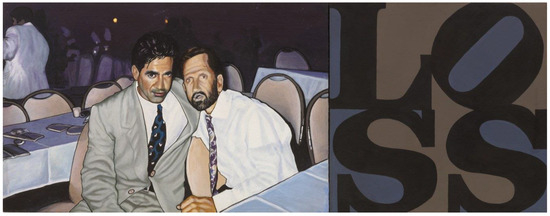
Figure 11.
Joey Terrill, My Friend Peter (LOSS), acrylic on canvas, 60 by 24 inches, 1998–2023. Reproduced with permission from the artist.
RBM: We had initially pitched the idea of an exhibition focused on the Still-Lives, but really wanted to bring together a fuller picture of what the AIDS crisis was like for Joey.
JT: The same kind of sarcasm and humor that I would use to document my community, I then sort of maintained and transferred over to documenting post HIV cocktail. That’s one that I did last year for this show.
AS: Still Life with Cialis, Triumeq and a Drawing of my Friend Teddy Sandoval (Figure 12)?
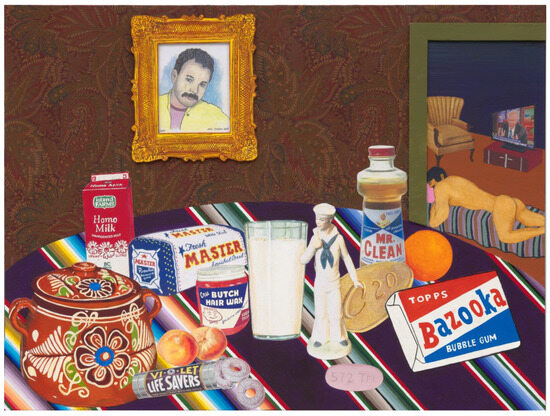
Figure 12.
Joey Terrill, Still Life with Cialis, Triumeq and a Drawing of my Friend Teddy Sandoval, acrylic and mixed media on canvas, 36 by 48 inches, 2023. Reproduced with permission from the artist.
JT: Yes, and in this one, because I wanted to pay homage to Teddy and intentionally fill it with as much homo innuendo as I possibly can, so there you’ve got homo milk.
AS: That’s a real thing! I didn’t know that brand!
JT: It’s a real thing! But you know, I think the logo and the branding probably is from the 1960s. I have a feeling they changed it. [In the painting] there is also Master enriched bread, Cru-Butch hair wax, violet Lifesavers—the candy mint with the hole.
AS: …Not to mention the violet/lavender connection to homosexuality and Oscar Wilde.
JT: I love that you get all the connections. [In the painting there is also] Mr. Clean, an antique porcelain sailor boy sculpture from Scotland, Cialis (the ED [erectile dysfunction] drug), Tops, Bazooka Gum, and then I have an image of a man lying there, and that would have been something that Teddy would have appreciated. But I have the TV set here with [Evangelical media mogul] Pat Robertson who died at 93, so I know Teddy is loving this; he’s laughing at it.
RBM: But that figure is purposefully drawn in a way that Teddy and you would have been drawing in the ‘70s.
JT: Yeah, Teddy and I would do these in a naive way of showing the queer body.
AS: You have such a consistent project of representing the queer body, through a long trajectory and prolific practice. I realize that so few of your pieces are in major collections and those that are, were purchased extremely recently.
JT: At that time as a young yeah—gosh, I was a young, beautiful, queer Chicano artist whose work was about those identities and that included the whole network of folks I was working with, some of whom are included in [the 2017 exhibition] “Axis Mundo” [Queer Chicano Networks in Chicano L.A.] There was us at this level, and the art world and museums way over here somewhere, very much out of reach, so out of reach that it never occurred to me that, oh, you know, scholars or academics or museum curators or directors were going to somehow be interested in the work that we were doing.
AS: You even parodied your distance from the established art work, like the 1981 Searching for Burritos which shows you with a bunch of people, a Good Humor ice cream truck, and the Guggenheim Museum in the background.
JT: And that’s kind of why and [the distance] shaped the work that we did. And I have wondered if in the ’70s there had been more of an interest in our work, how it might have shaped the direction of my work.
RBM: You described it as, and correctly, your artistic circle and then the art world. I also wanna highlight and remember, as an art historian, there was your art world, Jack, Mundo, Jef, Teddy, you, the Chicano art world, which was itself fighting for visibility.
JT: Yes. Exactly.
RBM: Then the rest of the art world that didn’t give two cents, up until the late 2010s. So another important aspect of this show that we don’t really talk about is within the groups of people that we lost during the AIDS crisis; the few gallerists that were actually interested in showing queer Chicano art, they died as well.
But going back to your circle, within the Chicano art world, there were, I won’t name them; very important Chicano and Chicana theorists and art historians that would not ever consider this as Chicano art in the ‘80s and the ‘90s, and would not include it in shows. And even when they would include works from people in your circle in shows, it was the most safe works that were not so visibly queer, visibly sexual. And a lot of people suffered from that. Roberto Gil de Montes did, you did, a whole slew of artists did.
3. Once upon a Time: Paintings, 1981–2015 10 September–23 October 2021, Ortuzar Projects
AS: Tell me about some of your earliest works from the Chicanos Invade New York series (Figure 13).
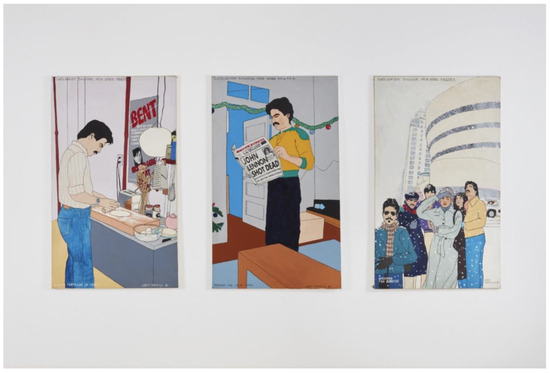
Figure 13.
Joey Terrill, the three panel series: Making Tortillas in Soho, Reading the Local Paper, Searching for Burritos, acrylic and metallic paint on canvas, each of the three panels is 60 × 36 inches, 1981. Collection of the Museum of Modern Art. Reproduced with permission from the artist.
Joey Terrill (JT): Yeah, so when I moved to New York in 1980, I had two goals in mind. First of all, I moved to New York because I had broken up with my boyfriend Rick. But when I moved to New York, my sister decided to move with me. She was here in third year at UC Santa Barbara. She called me up and said, “Hey, what if I come with you?” I said, “Oh my God, I would love it”. We were already coming to meet my friends, Steven and Victor, who were living here already. So here we were, like, four Chicanos coming from LA? And so I had two goals in mind. One was I wanted to see John [Lennon] and Yoko [Ono]. And you know, even if I just saw them in Central Park I just wanted to wave at them or something and the other goal was to exhibit my art? But obviously, I didn’t get to see John and Yoko. Instead, I was four blocks away the night that he was murdered. I ran down there and just stood there for eight hours, stunned in the cold, as did many others in New York. It was such a mass grieving process for everyone. So that became the kind of focal point of my moving to New York. It was a global and cultural trauma.
So in April of ‘81, I was assigned to this alternative art space called Windows on White Street, which is about two blocks down [from Ortuzar Projects]. And it was just a business that had three windows, and the business owner would allow artists to exhibit there. It would alternate in just, you know, one month someone would exhibit. And so these paintings were determined by the number of windows and the size of the windows. So it’s my only work that has been determined by a site-specific location. And I titled them Chicanos Invade New York [(triptych) [1981 (left to right) Making Tortillas in Soho, Reading the Local Paper, Searching for Burritos] because it’s sort of, you know, a humorous viewpoint because literally in 1980 you could count the number of Mexicans in New York on one hand. But as you can see I did one called Making Tortillas in Soho and because it never occurred to me how much we would be missing and craving Mexican food and tortillas. You couldn’t find them in New York at that time. So I called my uncle Rudy and asked, “Uncle Rudy, how do you make tortillas? What’s the recipe?” And he laughed and he told me. So, there I was making tortillas. And I remember thinking, oh, that’s so funny. Like people come from all over the world to Soho to make art. And I come here and I’m making tortillas. And then the middle piece is Reading the Local Paper which of course the headline reads “John Lennon Shot Dead”.
And then this piece is called Searching for Burritos. And it’s me, Victor Durazo, Steven Fregoso, my sister, and our friend Eddie Dominguez. I don’t know if you know Roberto Gil de Montes, the artist, Eddie Dominguez is his longtime partner and today husband. Eddie and Victor had been dancers with the [Mexican folkloric dance ensemble] Ballet folklórico [de México] and was visiting us in New York, so I was determined to do this painting of us, you know, jokingly searching for burritos in front of the Guggenheim, in a blizzard. So that was from ‘81, and now 40 years later, and back on White Street [where Ortuzar Projects is], with this one-man show, which I never expected would be the case. And so these other paintings are sort of from the ‘80s and ‘90s, and they evoke this LA/New York, back and forth trajectory [that I was on].
Then this is from 1981, which I did here in New York. And it’s Portrait of Joey Arias (Figure 14) who’s the New York icon of the underground scene and he has his own cult following to this day. And what many folks don’t know, was that he went to high school in Los Angeles, Cathedral High School. He was a senior when I was a freshman. I had a big crush on him because I thought, “Oh my god, he’s so into rock and roll he’s got a shag haircut and he’s so cute”. And we kind of, you know, our friends followed him in LA and then when he moved to New York the next thing we knew he was on Saturday Night Live singing backup with Klaus Nomi for David Bowie and that was just astounding for us. So when I moved to New York I looked him up and he was working at Fiorucci which was the store of the moment. It was Italian but it was the height of New Wave. Joey worked there, but people would go there to see him. And he would kind of hold court, and there’d be like paparazzi, and he’d be posing. He had green hair, and then the next week, he had pink hair. But also his band at the time was called Strange Party and we went to go see him at a club downtown. What I loved about it was that every band member came out totally dressed like they were all from different eras or movies. So somebody came out in shorts with a big beach ball like they were at the beach with sunglasses. Someone else came out dressed like Alice in Wonderland or somebody like a soldier, and I just loved all that kind of clash of creativity. But they ended the set by bringing out a big piñata and hitting it. And I saw all these underground New York club kids loving it and I remember thinking, “It’s a piñata, we used to do that all the time for our birthday”. So I chose to paint his portrait this way and it’s set in Times Square and I chose to have two people walking by holding a backdrop with a pair of cartoony cactus with maracas to make a surrealistic and funny scene.
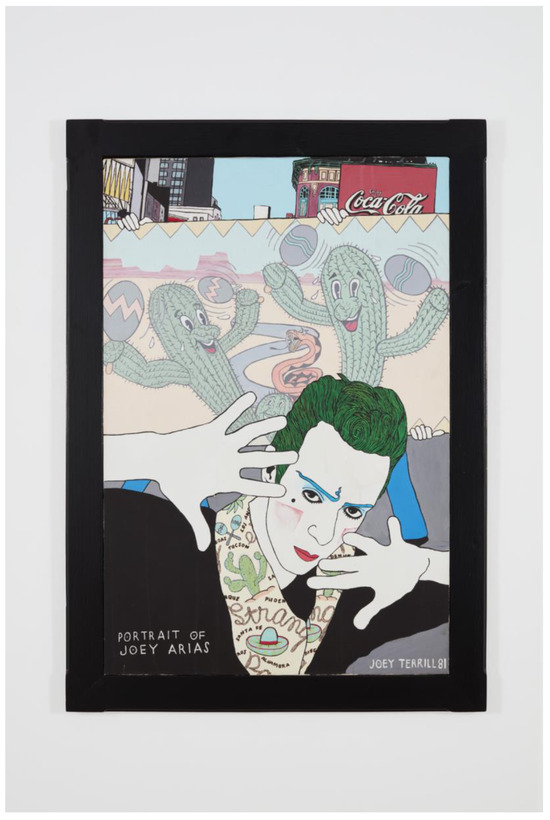
Figure 14.
Joey Terrill, Portrait of Joey Arias, acrylic on canvas, 41 3/8 × 29 3/8 inches, 1981. Reproduced with permission from the artist.
AS: It makes me think of [Chicano artist collective] Asco’s murals in the streets of Los Angeles.
JT: Yeah, and you know, I was always on the periphery of Asco as well and I have to say that I just did this interview here with someone who’s doing a piece on Asco. There was a certain core group and then people came in and out, there was all this fluidity. Asco embraced everyone. I never felt like, “oh, being queer/gay/anything was off the table, or somehow being marginalized”. And I’m so glad that we had that in East LA, because it just lent itself to a lot of other kinds of creative circles and strategies.
This one is titled Vickie and Sue Say What about Bamboo House? (Figure 15). It is an image from the ‘80’s when I would visit New York at least twice a year because Victor and Steven still lived here, so I always had a place to stay, which made it very easy. At that point they were living in the East Village where there was this whole scene that was happening and I loved it. Those were my friends, Vickie, the dark haired young woman on the right and Sue, her girlfriend in the middle. This was the Pyramid Club and I think we had just come out of there and it was starting to snow, and we were starving trying to figure out where to eat, and you don’t see Victor and Steven, but I’m shouting to them, “Hey, Victor and Steven, what about Bamboo House?” which was a Chinese restaurant in the East Village that people used to like to go to. I’m not sure if it’s still there because so much has changed. So that’s that one. And then when I moved back, after I exhibited my work in ‘81, Rick, the love of my life, said, “Come back to LA, come back to California. It’ll be different, we’re gonna make it work”. And I’m like, “Okay”. So I came back and within three years, we finally broke up for good. I was devastated. I was determined to then make a sort of fotonovela in paintings or comic strips of the breakup and what I was going through resulting in Breaking Up/Breaking Down from 1984/85.
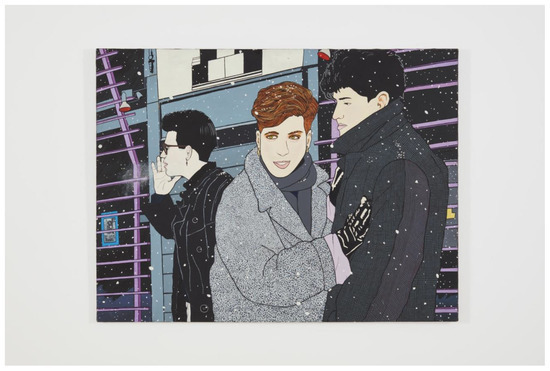
Figure 15.
Joey Terrill, Vickie and Sue Say What about Bamboo House?, acrylic on canvas, 30 × 40 inches, 1985–1988. Reproduced with permission from the artist.
I tend to parody and make fun of myself. That first self-portrait in this set of paintings was a visual representation of my mindset at the time. I was just devastated. I felt like I was in quicksand, I was stuck. It was just abysmal, it’s terrible. And then you can see the panels following and this top one which is titled He Wore Ray Ban Glasses, a Rolex Watch, and He Used to Eat My Ass, shows you that Rick liked quality, right? But also, because he left me for a millionaire. He dumped me for a sugar daddy. And, you know, that was like…
AS: I know that story all too well.
JT: You know what I mean? I told him, I said, “Come on, you know I can never compete with a millionaire. Please, if that’s what you want, go”.
AS: Exactly. Such a betrayal, yet, they make it easy sometimes.
JT: Yeah, sometimes, yeah, it is easy. But it was still, I mean, I was devastated. And as I was moving out of the townhouse, and I remember as I was packing, I thought, “Oh, all the really sharp knives belong to him”. I went, “Oh, God, that’s a metaphor. That’s a metaphor for it”. So I just included that. As much as this is all about me, I’m not like a selfie person, someone who likes to show my body, I’m very shy that way, but this is one time where I felt like it was important for me to show the depth of my sexual desire, longing, heartbreak, and I did that. God, I Miss Him So Much. And I know this is gonna sound weird, but my inspiration as I thought, “Should I do this? Is this too provocative?” I was remembering Frida Kahlo’s painting of her birth. I just remember how powerful that was. And you know, in her mother, you didn’t see her mother’s face, it was just her head popping up. And it’s still in my head. I remember thinking, “You know, I hope you don’t see my face”, that I am able to be that direct and authentic and in a way, confessional, in my narratives.
AS: That’s such a beautiful history and link to Chicana feminist narratives.
JT: I went to college in the early ’70s and attended Immaculate Heart College. And at that time, I mean the whole zeitgeist was feminism. There was this program that was at CalArts as well as Immaculate Heart, so I was studying all these women artists. It’s the first time that I really got to explore the work of Frida Kahlo. We were looking at art history and things like ‘woman as image and imagemaker,’ ‘the male gaze,’ and ‘the personal is political’. And so I absorbed all that and thought, you know, for my intentions, being Chicano, being marginalized, living in a city, right, where, as Harry Gamboa [Jr.] once said, “We’re a “phantom culture”, we’re all around here, but we were ignored, we were invisible”. So I was always invested in wanting to both paint and visualize my Chicano identity, but also my gay identity, because there were issues within the Chicano community, with misogyny, with homophobia, violence, all that cultural machismo.
I felt like I was carrying the world on my shoulders, taking drugs, hallucinating all kinds of religious, passionate, and romantic stuff. And there is a reference to Eydie Gormé and Trio los Panchos, which was an album that every Chicano I knew had. And so when we broke up, I would listen to it—I’m a big romantic at heart. And then in that one, hanging above my head, there was a collage that was painted over that I had done in the ‘70s for the Fridamania show, which was also in Mexico City. And it was titled If Andy Had Been Born in Mexico City. And so I was referencing Andy Warhol, saying if he had been Mexican, he would have depicted Frida instead of Marilyn.
Everything I was reading was dysfunctional and sad and gay, including Narrow Rooms by James Purdy. And then the final one, I’m crying because I would do that a lot. Of course I’m eating ice cream to kind of self-medicate. And then ending with, like a question, one year later, “Will I be strong?” in this sort of cartoon version of Hollywood and natural paradise as a contrast.
AS: There is a luscious and austere narrative in this work that lends itself to metaphors about queer fertility and the ways that we kind of propagate ourselves in the world that are not necessarily about heteronormative ideas of raising children but rather about the blooming of the self.
JT: Artists like Teddy Sandoval, myself, Jack Vargas, Mundo Meza; gay Chicano artists doing works that looked at Chicano men, but reading, crying, cooking, you know, in the kitchen, which is usually the domain of the female, right, especially within the canon of like the Chicano, la familia, blah, blah, blah, which I kind of rebelled against sort of, so…
AS: It is so clear to me that your work both revels in and transcends male homosexuality, fully embracing queerness. It starts from your experience and that of your subjects, of course, and proceeds to speak to something bigger.
JT: I always felt it was important for me to paint. There were a lot of gay men who were painting images of masculinity and other gay men, you know, their sexuality, but I always felt it was important for me to want to paint my lesbian friends as well and my cousin Pat and her partner and whatever. And I thought, “You don’t see that a whole lot. You don’t see those relationships of the gay brothers and sisters and how we form our chosen families”. So there’s several that I have done. And in fact, years ago, a lesbian said disgruntled, “You know, you’re telling our stories!” “Excuse me”, I said, “I’m not, I’m telling my story”. I said, “Please, I’m an artist, and I’m telling my story, choosing to paint the women that I love and cherish as friends and family. Sorry, but that’s what it is”. And I’m not trying to say, “Oh, I’m speaking for all women or all lesbians”. I would never assume to do that.
AS: It’s tough as an artist or scholar. People come to you with their own stuff. And then you have to kind of let go and be like, “Oh wait, that’s them. They are working something out”.
JT: Yeah. And this painting was loaned for the exhibit. It’s one I did as a gift for my sister in ‘83 called Painted by Her Brother (Figure 16). That’s my brother-in-law in the background, who loaned it for this exhibit. My sister–we were very close; she was my younger sister. It was just the two of us. We were called two peas in a pod by the family and she died nine years ago of a very rare form of cancer. And I was like, “What the hell is going on with the universe?” That was never the way it was supposed to be. I was supposed to die of AIDS. And I always thought that my sister and my mother would have to grieve for the loss of their son and brother and instead I’ve outlived them. So I do take comfort in knowing that neither of them had to grieve for the loss of their son and brother. But I told my cousin I said, “I only wish Linda were here to see this. She would revel in it and be so supportive” and my cousin said, “Joey, she is there. She’s up there in the universe. She’s making things happen”. I said, “Okay, you’re right”.
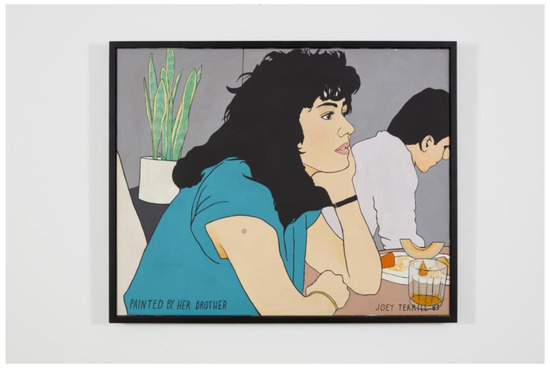
Figure 16.
Joey Terrill, Painted by Her Brother, acrylic on canvas, 25 by 31 inches, 1983. Reproduced with permission from the artist.
AS: Is part of your response to so much loss through your use of source photographs as a support to your painting practice? Your paintings rip moments of the ordinary, seemingly from the pile of photographs of all the things that have happened over the years, all the events that were worthy of taking a picture of, and then render some element of the photograph transcendent, an eloquent articulation of something much larger.
JT: So this painting is called Remembrance (Figure 17) from 1989. At the time, I wanted to do a painting that was, yes, about AIDS, but I wanted it specifically to be about our grieving for our missing friends, because a lot of the work around HIV and AIDS that was around or that I had access to or could see was sort of political. It was agit-prop and -- angry, you know, ACT UP, Gran Fury, which totally is appropriate, righteous, and amazing.
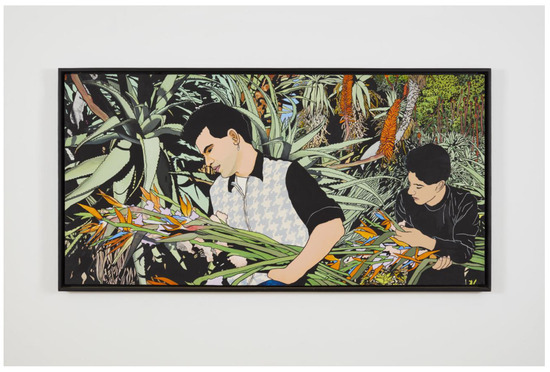
Figure 17.
Joey Terrill, Remembrance, acrylic on canvas, 24 × 48 inches, 1989. Collection of the Hammer Museum. Reproduced with permission from the artist.
And then within the Latino output, there were a lot of things, like wearing the red ribbon, and some would bring in religion by saying so-and-so is with the angels. So I wanted to do something that removed any religious connotation. I wanted my artistic response to clearly be based in Los Angeles or the Southwest and be related more to my cultural heritage. So that’s me in the middle, my boyfriend Robert at the time he was nine years younger and so we recognized that he was experiencing the death and grieving of all of my friends, my generation. No one from his circle of friends had gotten sick yet or died. He was a florist at the time, so I said, “Okay, give me some gladiolas, give me some birds of paradise”. The bird of paradise is the official flower of the city of Los Angeles, and we’re posing in front of the cactus and succulent garden in Beverly Hills.
AS: I see.
JT: And I wanted us to be engulfed, sort of all encompassed by the landscape. I was also thinking of gardens as metaphors for sexual exploration, desire. And at the same time while it is beautiful, it’s also kind of threatening. You don’t want to fall into those spikes. Which to me was a visual metaphor for sex at that time. At a time where you wanted intimacy and needed to reach out to one another and sometimes be sexual as part of the grieving that you were going through you were taking a risk with your own life. It was fraught with risk and potential danger. So yeah, that’s what we did. But I think what’s also important in this work was that one of my favorite shirts that I’m wearing there with the houndstooth pattern was designed by my friend [fashion designer] Arnie Araica, who was from El Salvador, but was living in L.A. He had a clothing line, selling his designs at Jef Huereque’s shop Modern Objects on Melrose. But Arnie was getting sick. And I remember he told me, “I’m so glad you included my design”. He said, “Because I know I’m not going to live, but my design will live on”. And he was correct. But this painting belongs to Michael Nava, the writer. And he says he loves it, and I’m glad that it’s his.
AS: It’s an extraordinary painting.
JT: Thank you. From 1989 to 1991, I would have these themed Halloween parties when I lived on Fifth Street and would take two weeks to blankstock the dining room and living room.
AS: What does blankstock mean?
JT: Well, me and Rick used to hang wall covering. And when you do a job or you’re hanging wall covering, you want to get the walls as smooth as possible. So what you do is you first paper them with what’s called blankstock and it pulls it really tight and smooth. It’s kind of like prepping or adjusting the canvas.
AS: That makes sense. I should have known that. My mom used to hang wallpaper as a sidegig.
JT: But it’s just blank. And so I could then paint and draw and collage and do all these things. And at the end of the day, I could then just peel it all off so the landlord wouldn’t be upset. This is called Tom Gutierrez [2001], and Tom was partnered with a friend of mine, William, who’s actually here in New York, and he’s going to be at El Museo later tonight. Tom came to one of my parties as Pierrot the Clown. Tom was a very handsome Italian, really nice guy. Within a year he was dead. One of the things that we recognized with the parties was that I would invite artists, designers, musicians, club kids, family members, and we all would get very creative and go overboard with our outfits and partying because it was a rebuke to all of the death and dying that was going on around us.
And as you can imagine, one year we’d have you know certain people there and we knew by the next year they were gone. But also, back then it wasn’t about cell phones and Instagram. So we would take all these photographs and then about two weeks later I’d have a picture party so that everybody that could would come back to share the pictures that were developed. We would have so much fun looking at the pictures. We’d trade them with each other, and eventually those became image sources for this series of paintings.
AS: I love that as a source for these paintings, this form of sociality through image making. I studied a collective of artists in the 90s who would videotape themselves and then go back and have parties with viewings of the videos. And it makes me think of Nan Goldin’s slide shows, too, which of course were public works, but also were for her intimate circle.
JT: Yeah definitely; because we were hindered by a lack of technology, we worked together in much more intimate ways with what was available.
AS: Yeah.
JT: And the middle one, that’s my friend Oscar [Oscar/Ernesto, Figure 18]. He is alive and he is as sweet and cherub-like as he appears. He looks like he’s 12 years old, he’s a retired teacher now, but he taught second grade. He had the personality of you know…I could see second graders loving him as a teacher. But in this scene here, I’ll just point out that the theme that year was “Hell’s Angels” and it was just a loose theme that I would put on the flyer to send out to people. But the walls were decorated with images from Fellini’s Satyricon. And then that artwork in the gold frame that’s a painting by Teddy Sandoval that he’d given to me as a gift that I cherish to this day. And then the calla lily and the skulls are painted Xeroxes of Robert Maplethorpe photographs. And then there’s Maxfield Parrish and Baron von Gloeden. So, I would make these copies of different kinds of queer artists and homoerotic imagery and color them and put them all over the walls.
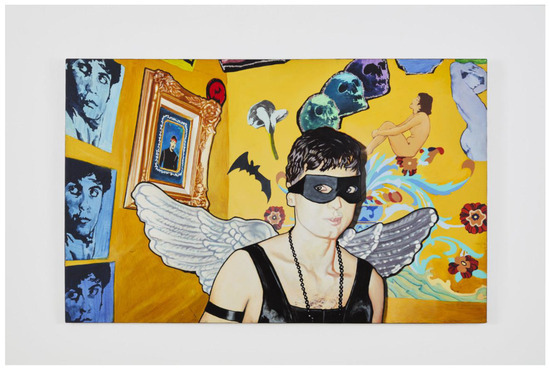
Figure 18.
Joey Terrill, Oscar/Ernesto, acrylic on canvas, 30 × 48 inches, 1992–1993. Reproduced with permission from the artist.
Then this one here is called Jef, Victor, Luiz and George (Figure 19). Jef and Luiz have flowers in their hair and they’re partners to this day and they came dressed as the painting Las dos Fridas. If you look closely you can see they have these velvet hearts on their chest and then there’s plastic tubes which replicate the veins of blood. When someone would say, “okay I’m gonna take a picture”, they would sit and pose like the painting. But in my painting they are not posing, this is a very candid shot. And so right there, the back of the head with the red hair in a big beehive hairdo, that’s Arnie, who designed the shirt over there who used to sell his things at Jef’s shop, because Jef was a designer as well. And then Victor Durazno was a dancer for the Ballet folklórico. We grew up in Los Angeles and he was one of my best friends since we were teenagers. He’s the one with whom, when I moved to New York, we lived with. This scene is back in LA though. And then Luiz, Jef’s partner, was also a teacher at L.A. Unified School District. He was also a musician in a band called Fat and Fucked Up. And they would play these punk clubs. Fat and Fucked Up would come out and they were a quartet. Someone played a bass and Luiz would be there playing the violin and the crowd loved them. It was such an incongruous musical form for the punk clubs. Anyway, Victor and his partner, George, they kind of came as Italian Renaissance royalty. Victor died about seven years ago from cancer.
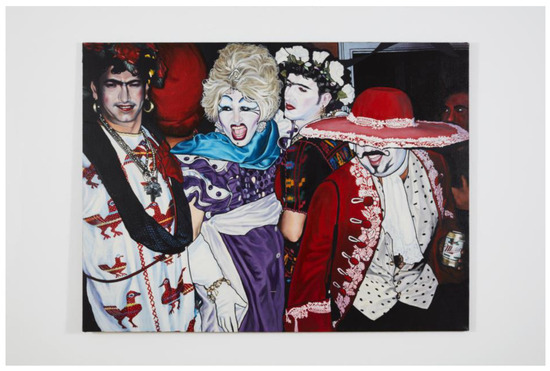
Figure 19.
Joey Terrill, Jef, Victor, Luiz and George, acrylic on canvas, 36 × 48 inches, 1992–1993. Collection of the Museum of Contemporary Art San Diego. Reproduced with permission from the artist.
Then this is the most recent painting in the group. This is from 2015 and it is titled My Last Day in New York, Fire Island—1981 (Figure 20). When I was about to fly back to LA to go back to California, to go back to Rick, I was contemplating, “am I doing the right thing, I’m not sure, blah blah blah”. I had two co-workers that had said, “Hey Joey, have you gone to Fire Island [a gay vacation spot] since you’ve been here?” I said, “No”. They said, “Come on, we’re gonna take you down there”. We went on the subway and took a ferry. We got down there and they were just taking pictures of me. I wasn’t even aware that they were doing that but it was off season and the sea was kind of choppy. So I was in a very contemplative mood at that time, but also unbeknownst to me, I was already infected with HIV. And so these are pictures that were just sitting at home like in a box. Then in 2005 I realized that I was now reaching the point when I was infected with HIV when I was 25, and now I will, from this point forward, be living with HIV longer than I had been living without it. And it did a number on me. I was like, wow, that is amazing. So I started to look at old pictures from when I was living in New York back in 1980 and ‘81 and that is when I started to use those images for paintings in the 2000s kind of just referencing the New York days.
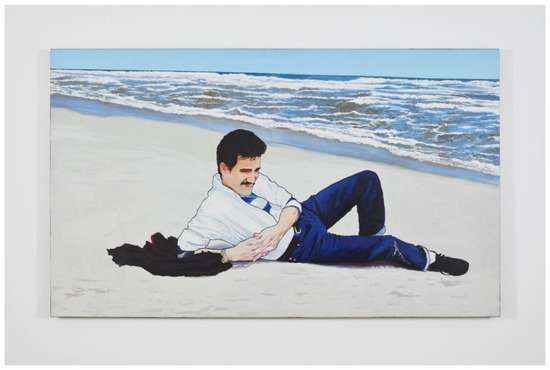
Figure 20.
Joey Terrill, My Last Day in New York, Fire Island-1981, acrylic on canvas, 36 × 60 inches, 2015. Reproduced with permission from the artist.
And then this last little painting over here is of me and Rick when I had moved back to LA and it’s titled Not All Our Lovemaking Had to Smell of Poppers (Figure 21) and because I recognize that however dysfunctional we were and however dramatic our relationship was whether we did drugs or not there was some true love there. That was my version of indicating that. So that’s sort of the range of what’s here.
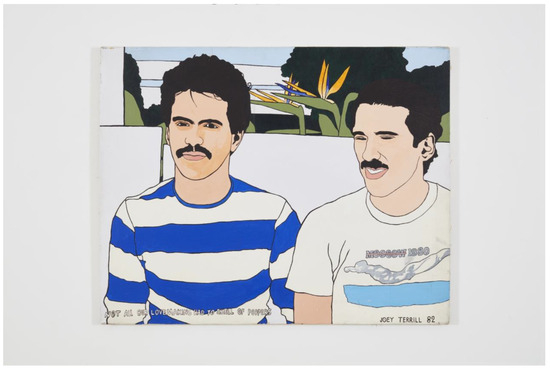
Figure 21.
Joey Terrill, Not All Our Lovemaking Had to Smell of Poppers, acrylic on canvas, 24 × 30 inches, 1982. Reproduced with permission from the artist.
AS: It’s so wonderful to see your work in person. Aside from the Axis Mundo exhibition, this exhibition is my first opportunity.
JT: Oh, great. Well, you know, the thing with Axis Mundo is that it focused more on the performative stuff that we were doing with the Maricón series and me and Teddy in our collaborations. And I remember as that show moved to different locations and I would go and speak at each of the openings. It was apparent to me and the curators Ondine and David who said, “Wow, this doesn’t even include your paintings”. I said, “Yeah, well, maybe up the road”.
AS: In the field of queer Latinx art, there’s so much work for all of us to do, which is exciting and heartbreaking at the same time.
JT: While I don’t have a degree to teach, when I have spoken to young students, especially queer Latinx students who are very focused on queer Latinx images, I say, “You know what? Do yourself a favor, go and look at other art. Go look at 18th century English portraiture. Go look at the abstract expressionists. Go look at pop artists of the 60s. You will see things and develop ideas that might awaken things within you and help create new strategies. If you’re gonna do oil painting, guess what, there’s centuries of oil painting. You are a part of a conversation that continues through the centuries. What do you bring to that conversation? What are you doing that’s different and/or filters into what’s already being done? Or are you expanding the history of oil painting?”
AS: That’s such a useful pedagogical remark.
JT: I think it is, and I certainly have felt that way myself. But you know, when you go look at work that someone else has done, to me, you’re learning about yourself in the same way that a critique of work sometimes says more about who’s doing the critiquing. When you’re approaching something and I think, “gee, I don’t like this”. Why don’t I like it? What is it in my work that is different?” You know It just helps me think about these things in the process, and I think, make better art.
AS: This has been such a pleasure. Thank you.
Funding
This research was funded by the Walton Family Charitable Support Foundation through the endowed Assistant Professorship at the University of Arkansas, which funded travel to the artists’ exhibitions and to meet with the artist.
Data Availability Statement
More information about the two exhibitions discussed in this article is available at https://www.ortuzarprojects.com/exhibitions/joey-terrill and https://www.marcselwynfineart.com/exhibitions/joey-terrill, accessed on 20 March 2024. More information about Joey Terrill’s work is available at his website, http://joeyterrillart.com/, accessed on 20 March 2024, and his Instagram account, homeboybeautiful.
Conflicts of Interest
The authors declare no conflict of interest.
Short Biography
Dr. Alexis Salas holds the position of Endowed Assistant professor of the arts in the Americas with a specialization in Latin and Latinx art and visual culture at the University of Arkansas. She is currently in the research phase of a book length project on queer Latinx art and activism which historically grounds relationships of Latinx art to political movements such as the US Civil Rights movement, the international AIDS crisis, and marriage equality. The project theorizes how queer Latinx activism and art have mutually informed and advanced one another. She wears her reproduction of the “malflora” t-shirt often.
Joey Terrill (b. 1955, Los Angeles) lives and works in Los Angeles. Joey Terrill joins diverse mediums of zine-making, performance, printmaking, collage, and painting in a body of work that tenderly encompasses his intimate experiences of intersecting queer, Chicano, and artistic communities. Drawing from the existing visual culture surrounding him, Terrill combines personal photographs, found pop cultural imagery and reproductions of artworks by queer predecessors to conjure utopian landscapes. Recognized for his enduring AIDS activism, Terrill served as the Director of Global Advocacy and Partnerships for the AIDS Healthcare Foundation until recently. Joey Terrill: Still Here, the first monograph devoted to his AIDS-related works, was published in 2024.
Disclaimer/Publisher’s Note: The statements, opinions and data contained in all publications are solely those of the individual author(s) and contributor(s) and not of MDPI and/or the editor(s). MDPI and/or the editor(s) disclaim responsibility for any injury to people or property resulting from any ideas, methods, instructions or products referred to in the content. |
© 2024 by the author. Licensee MDPI, Basel, Switzerland. This article is an open access article distributed under the terms and conditions of the Creative Commons Attribution (CC BY) license (https://creativecommons.org/licenses/by/4.0/).